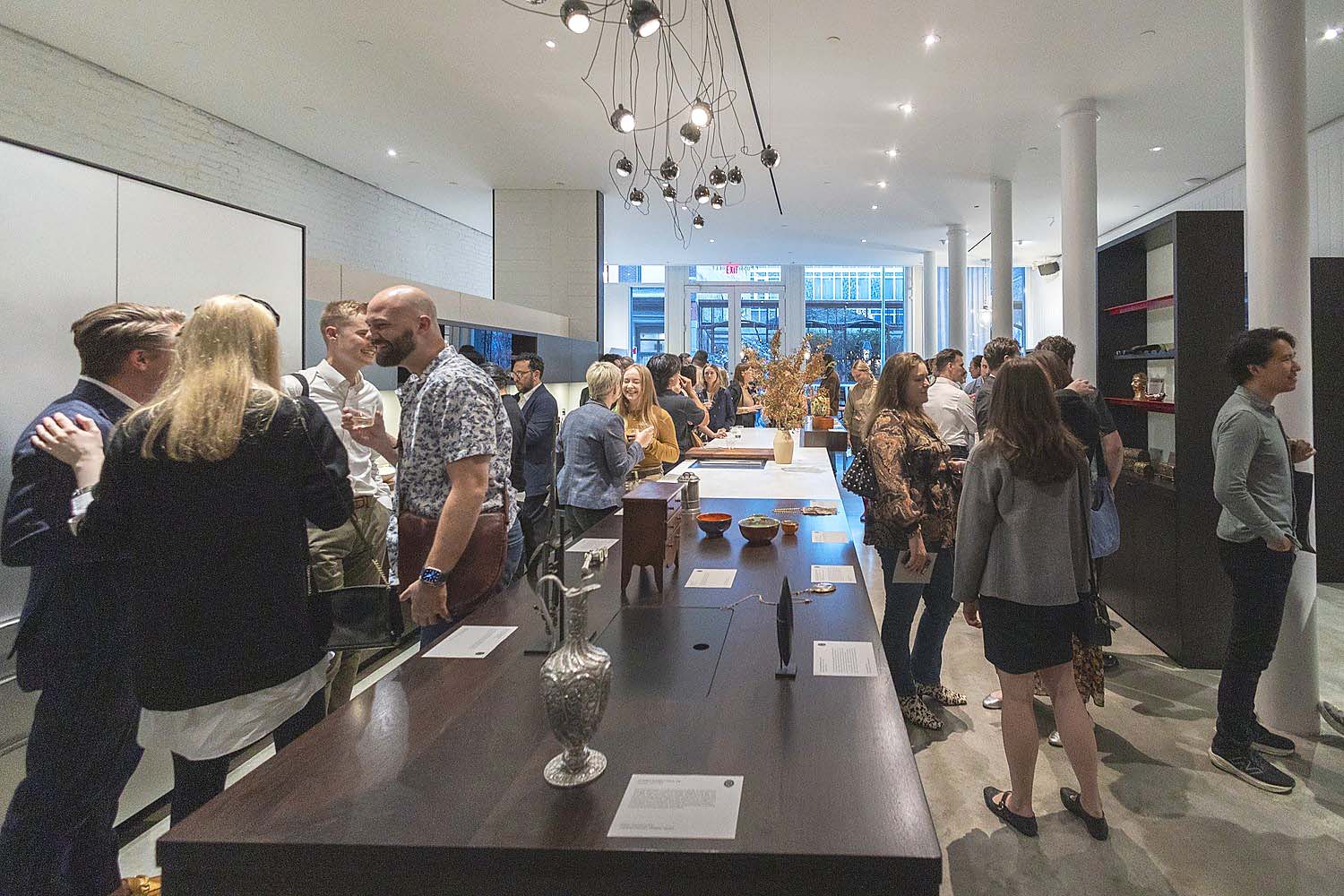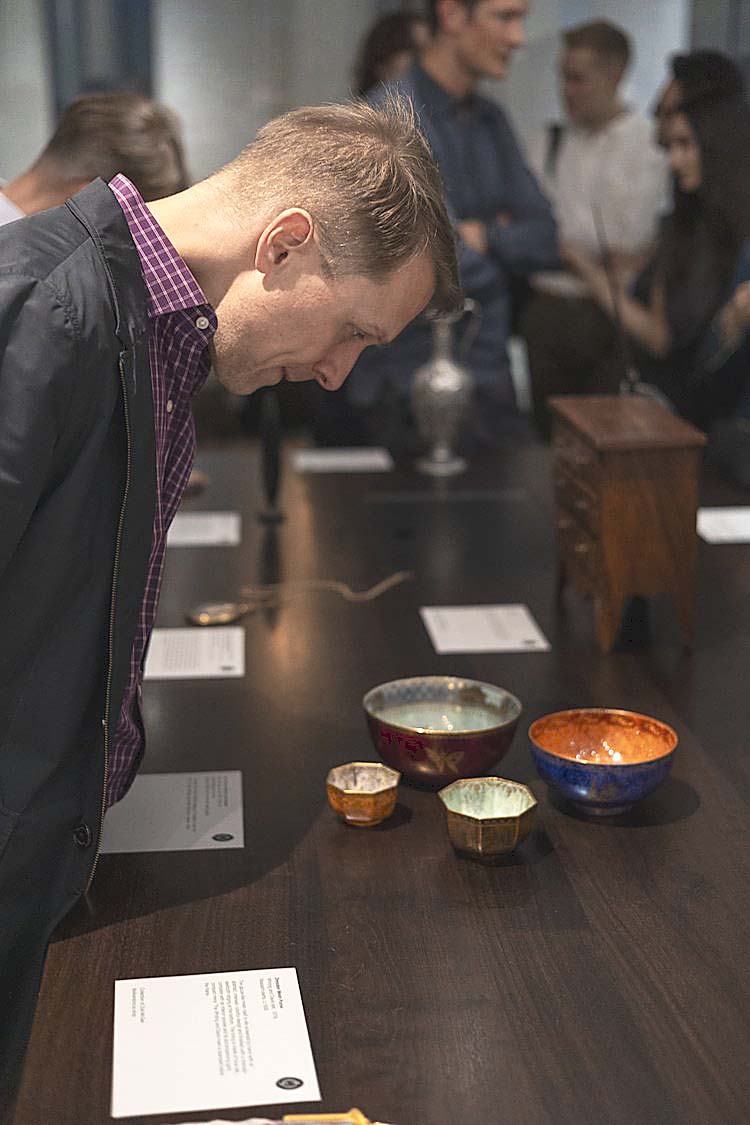
The Henrybuilt space at 12 Crosby Street was the well-attended — and perfect — venue to chat with friends, make new ones and enjoy a beverage or appetizer while examining a selection of loaned objects. Photography by Michael Assis, Terra Orbis.
Review & Onsite Photos by Madelia Hickman Ring
NEW YORK CITY — Anyone worried about the future of the decorative arts will be pleased to know about a new organization called the Fine Objects Society (FOS), which on October 3 made its official launch at an intimate hands-on exhibition at Henrybuilt’s SoHo showroom. About 150 folks of varying age and professional backgrounds attended, with more coming to see the exhibition while it was on view October 4-6.
Titled “Please Touch,” the event featured a few dozen decorative objects lent from several individuals, many of which are the founding members of the Fine Objects Society: Ben Miller (president), Brenton Grom (treasurer), Sarah Margolis-Pineo (secretary), Bailey Tichenor, Michael Hilal, Jeremy Simien, W. Taylor Thistlethwaite, Oliver Newton, Monica Nelson and Zoë McGee. In addition, Teremok Antiques and Walker Decorative Arts contributed pieces to round out the selection.
Miller, who is the director of research at S.J. Shrubsole and the host of The Magazine Antiques’ podcast, “Curious Objects,” interrupted the socializing for about five minutes to share the mission of the FOS with those in attendance.
“Fundamentally, Fine Objects Society is a community for people who believe in a bright future for the decorative arts, which we know looks different from the past. But, we embrace that change,” Miller said. “We know that upcoming generations have the potential to become truly great collectors and curators and connoisseurs and dealers and interior designers and scholars, and you name it. That potential is extremely strong; the problem is that we’ve lacked the infrastructure necessary to support those people and to foster that interest. We think there’s a path forward for a new golden age of collecting — that’s what Fine Objects Society is here to do.”

From left, Fine Objects Society president Ben Miller and treasurer, Brenton Grom.
The objects on view were, in his words, meant to emphasize “the central part these things can play in your daily life. They inspire joy and moments of contemplation, every time you pour a cup of tea out of your favorite teapot or light candles in your favorite candlesticks.
They were made for daily life, they were not meant to be put on a pedestal, to be sacred or untouchable, but that doesn’t mean they are not valuable or meaningful or admirable or beautiful.” Before he passed the baton to Grom, he confirmed objects were available for purchase.
Grom, the executive director of the Webb Deane Stevens Museum in Wethersfield, Conn., followed Miller by thanking him for his vision and making a pitch for membership enrollment.
“In a matter of a few months, we were able to bring together a core team who envisioned this whole thing. Then, that we could populate the guest list tonight with an entire roomful of people is incredibly powerful.” Comparing the enthusiasm he saw to that in the late Nineteenth and early Twentieth Centuries when collecting antiques became popular, Grom noted it was “usually a social experience. The fact that we have this room full of people, many of whom are not necessarily at these certain kinds of events, particularly in this city, bodes well. We’re all just really excited to see where this goes.”

A group of four “ordinary” lustre bowls, made by Daisy Makeig-Jones (1881-1945) for Josiah Wedgwood & Sons, England, 1920s, bone china with lustre glazes, from Artistoric, Photography by Michael Assis, Terra Orbis.
What was there to examine? Bailey Tichenor, a principal at Artistoric, supplied several things, including some lustre bowls made in the 1920s for Josiah Wedgwood & Sons, a Belgian circa 1930s stoneware vase made by Charles Catteau for Boch Frères Keramis and a Moonstone vase made for Wedgwood by Keith Murray in the 1930s. Miller pulled from his collection an Etruscan or Roman-inspired Antinous mirror and stand, made by Thomas Lollar and Ricardo Arango in 2022 from welded steel, a dyed and woven rivercane herb basket made in the Southern US around 1910 by an unknown Cherokee weaver and a late Eighteenth Century pewter tankard made in London by Thomas Compton.
Jeremy K. Simien showed a Navajo squash blossom necklace, made in New Mexico circa 1920 and Brigadier General Philip Barbour’s circa 1825 miniature portrait that was attributed to Jean Francois De Vallée; both had provenance to the Peyton Wright Gallery. Guests couldn’t resist picking up and looking through a pair of French circa 1900 plated silver and mother-of-pearl opera glasses. Two iron locks — one Eighteenth Century French, the other Eighteenth or Nineteenth Century Japanese — from Teremok Antiques were both sculptural and impressive in their scale, as was an Indian engraved steel push dagger or katar, made in Vijayanagara, South India, circa 1550-1650, that Walker Decorative Arts noted was comparable to one in the collection of the Metropolitan Museum of Art. Also from Walker, an Iznik polychrome pottery spandrel tile fragment, made in Ottoman Turkey around 1580 and a circa 1920 Japanese Ikebana basket.
An American carved wood crow pull toy and English miniature three-drawer chest were provided by Taylor Thistlethwaite while a few Shaker objects were loaned by Sarah Margolis-Pineo, a Lenox-Mass.,-based associate at John Keith Russell Antiques and director of programs at Edith Wharton’s The Mount.
The Fine Objects Society will host a series of upcoming events, with members — an annual membership costs just $120 — getting priority access to programs, members-only events and an annual members-only retreat. For further information, www.fineobjectssociety.org.

















